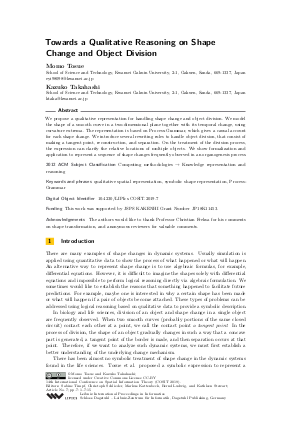Towards a Qualitative Reasoning on Shape Change and Object Division
Authors Momo Tosue, Kazuko Takahashi
-
Part of:
Volume:
14th International Conference on Spatial Information Theory (COSIT 2019)
Part of: Series: Leibniz International Proceedings in Informatics (LIPIcs)
Part of: Conference: Conference on Spatial Information Theory (COSIT) - License:
 Creative Commons Attribution 3.0 Unported license
Creative Commons Attribution 3.0 Unported license
- Publication Date: 2019-09-03
File

PDF
LIPIcs.COSIT.2019.7.pdf
- Filesize: 1.61 MB
- 15 pages
Document Identifiers
Subject Classification
ACM Subject Classification
- Computing methodologies → Knowledge representation and reasoning
Keywords
- qualitative spatial representation
- symbolic shape representation
- Process-Grammar
Metrics
- Access Statistics
-
Total Accesses (updated on a weekly basis)
0PDF Downloads0Metadata Views
Abstract
We propose a qualitative representation for handling shape change and object division. We model the shape of a smooth curve in a two-dimensional plane together with its temporal change, using curvature extrema. The representation is based on Process-Grammar, which gives a causal account for each shape change. We introduce several rewriting rules to handle object division, that consist of making a tangent point, reconstruction, and separation. On the treatment of the division process, the expression can clarify the relative locations of multiple objects. We show formalization and application to represent a sequence of shape changes frequently observed in an organogenesis process.
Cite As Get BibTex
Momo Tosue and Kazuko Takahashi. Towards a Qualitative Reasoning on Shape Change and Object Division. In 14th International Conference on Spatial Information Theory (COSIT 2019). Leibniz International Proceedings in Informatics (LIPIcs), Volume 142, pp. 7:1-7:15, Schloss Dagstuhl – Leibniz-Zentrum für Informatik (2019)
https://doi.org/10.4230/LIPIcs.COSIT.2019.7
BibTex
@InProceedings{tosue_et_al:LIPIcs.COSIT.2019.7,
author = {Tosue, Momo and Takahashi, Kazuko},
title = {{Towards a Qualitative Reasoning on Shape Change and Object Division}},
booktitle = {14th International Conference on Spatial Information Theory (COSIT 2019)},
pages = {7:1--7:15},
series = {Leibniz International Proceedings in Informatics (LIPIcs)},
ISBN = {978-3-95977-115-3},
ISSN = {1868-8969},
year = {2019},
volume = {142},
editor = {Timpf, Sabine and Schlieder, Christoph and Kattenbeck, Markus and Ludwig, Bernd and Stewart, Kathleen},
publisher = {Schloss Dagstuhl -- Leibniz-Zentrum f{\"u}r Informatik},
address = {Dagstuhl, Germany},
URL = {https://drops.dagstuhl.de/entities/document/10.4230/LIPIcs.COSIT.2019.7},
URN = {urn:nbn:de:0030-drops-110998},
doi = {10.4230/LIPIcs.COSIT.2019.7},
annote = {Keywords: qualitative spatial representation, symbolic shape representation, Process-Grammar}
}
Author Details
- School of Science and Technology, Kwansei Gakuin University, 2-1, Gakuen, Sanda, 669-1337, Japan
Funding
This work was supported by JSPS KAKENHI Grant Number JP18K11453.
Acknowledgements
The authors would like to thank Professor Christian Freksa for his comments on shape transformation, and anonymous reviewers for valuable comments.
References
-
Lledó Museros Cabedo, Luis González Abril, Francisco Velasco Morente, and Zoe Falomir. A Pragmatic Qualitative Approach for Juxtaposing Shapes. Journal of Universal Computer Science, 16(11):1410-1424, 2010.

-
Lledó Museros Cabero and M. Teresa Escrig. A Qualitative Theory for Shape Representation and Matching for Design. Proceedings of the Sixteenth Eureopean Conference on Artificial Intelligence, ECAI'2004, including Prestigious Applicants of Intelligent Systems, PAIS 2004, pages 858-862, 2004.

-
Anthony Cohn. A hierarchical representation of qualitative shape based on connection and convexity. Spatial Information Theory. A Theoretical Basis for GIS, COSIT'95, pages 311-326, 1995.

-
Manfredo P. do Carmo. Differential Geometry of Curves and Surfaces. Prentice-Hall, Inc., 1976.

-
Zoe Falomir, Luis González Abril, Lledó Museros Cabedo, and Juan Antonio Ortega. Measures of similarity between objects based on qualitative shape descriptions. Spatial Cognition & Computation, 13(3):181-218, 2013.

-
Antony Galton and Richard Meathrel. Qualitative outline theory. Proceedings of the Sixteenth International Joint Conference on Artificial Intelligence, pages 1061-1066, 1999.

-
Michael Leyton. A process-grammar for shape. Artificial Intelligence, 34:213-247, 1988.

-
Michael Leyton. Inferring causal-history from shape. Cognitive Science, 13:357-387, 1989.

-
Albert Pich and Zoe Falomir. Logical Composition of Qualitative Shapes Applied to Solve Spatial Reasoning Tests. Cognitive Systems Research, 52:82-102, 2018.

-
David Sabel and Hans Zantema. Transforming Cycle Rewriting into String Rewriting. Leibniz International Proceedings in Informatics, 36:285-300, 2015.

-
George Stiny. Introduction to shape and shape grammars. Environment and Planning B: Planning and Design, 7(3):343-351, 1980.

-
Momo Tosue, Sosuke Moriguchi, and Kazuko Takahashi. Qualitative Shape Representation and Reasoning Based on Concavity and Tangent Point. In Proceedings of the 31st International Workshop on Qualitative Reasoning, 2018.

-
Momo Tosue, Sosuke Moriguchi, and Kazuko Takahashi. Operations for Shape Transformations Based on Angles. In Proceedings of the 11th International Conference on Agents and Artificial Intelligence, to appear.

-
Lewis Wolpert and Cheryll Tickle. Principles of Development. OUP Oxford, 2011.

-
Michael Worboys. Using maptrees to characterize topological change. In Spatial Information Theory. 11th International Conference, COSIT 2013, pages 74-90, 2013.

-
Hans Zantema, Barbara Koenig, and H. J. Sarnder Brugging. Termination of cycle rewriting. Proceedings of Joint International Conference, RTA-TLCA 2014, pages 476-490, 2014.

